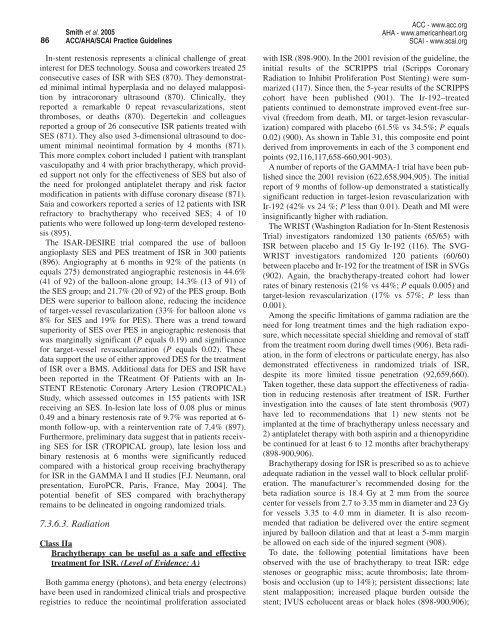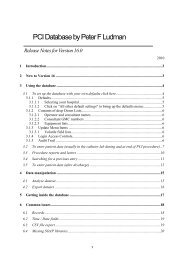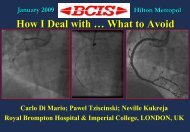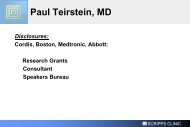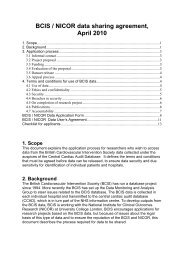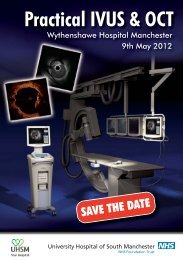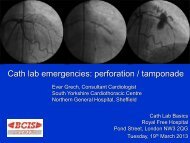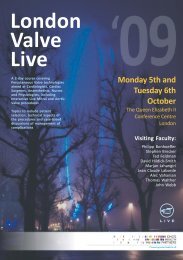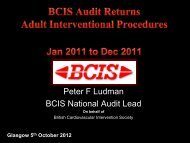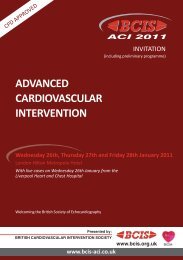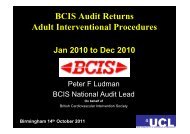Recommendations
ACC/AHA/SCAI PCI Guidelines - British Cardiovascular Intervention ...
ACC/AHA/SCAI PCI Guidelines - British Cardiovascular Intervention ...
- No tags were found...
Create successful ePaper yourself
Turn your PDF publications into a flip-book with our unique Google optimized e-Paper software.
86<br />
Smith et al. 2005<br />
ACC/AHA/SCAI Practice Guidelines<br />
ACC - www.acc.org<br />
AHA - www.americanheart.org<br />
SCAI - www.scai.org<br />
In-stent restenosis represents a clinical challenge of great<br />
interest for DES technology. Sousa and coworkers treated 25<br />
consecutive cases of ISR with SES (870). They demonstrated<br />
minimal intimal hyperplasia and no delayed malapposition<br />
by intracoronary ultrasound (870). Clinically, they<br />
reported a remarkable 0 repeat revascularizations, stent<br />
thromboses, or deaths (870). Degertekin and colleagues<br />
reported a group of 26 consecutive ISR patients treated with<br />
SES (871). They also used 3-dimensional ultrasound to document<br />
minimal neointimal formation by 4 months (871).<br />
This more complex cohort included 1 patient with transplant<br />
vasculopathy and 4 with prior brachytherapy, which provided<br />
support not only for the effectiveness of SES but also of<br />
the need for prolonged antiplatelet therapy and risk factor<br />
modification in patients with diffuse coronary disease (871).<br />
Saia and coworkers reported a series of 12 patients with ISR<br />
refractory to brachytherapy who received SES; 4 of 10<br />
patients who were followed up long-term developed restenosis<br />
(895).<br />
The ISAR-DESIRE trial compared the use of balloon<br />
angioplasty SES and PES treatment of ISR in 300 patients<br />
(896). Angiography at 6 months in 92% of the patients (n<br />
equals 275) demonstrated angiographic restenosis in 44.6%<br />
(41 of 92) of the balloon-alone group; 14.3% (13 of 91) of<br />
the SES group; and 21.7% (20 of 92) of the PES group. Both<br />
DES were superior to balloon alone, reducing the incidence<br />
of target-vessel revascularization (33% for balloon alone vs<br />
8% for SES and 19% for PES). There was a trend toward<br />
superiority of SES over PES in angiographic restenosis that<br />
was marginally significant (P equals 0.19) and significance<br />
for target-vessel revascularization (P equals 0.02). These<br />
data support the use of either approved DES for the treatment<br />
of ISR over a BMS. Additional data for DES and ISR have<br />
been reported in the TReatment Of Patients with an In-<br />
STENT REstenotic Coronary Artery Lesion (TROPICAL)<br />
Study, which assessed outcomes in 155 patients with ISR<br />
receiving an SES. In-lesion late loss of 0.08 plus or minus<br />
0.49 and a binary restenosis rate of 9.7% was reported at 6-<br />
month follow-up, with a reintervention rate of 7.4% (897).<br />
Furthermore, preliminary data suggest that in patients receiving<br />
SES for ISR (TROPICAL group), late lesion loss and<br />
binary restenosis at 6 months were significantly reduced<br />
compared with a historical group receiving brachytherapy<br />
for ISR in the GAMMA I and II studies [F.J. Neumann, oral<br />
presentation, EuroPCR, Paris, France, May 2004]. The<br />
potential benefit of SES compared with brachytherapy<br />
remains to be delineated in ongoing randomized trials.<br />
7.3.6.3. Radiation<br />
Class IIa<br />
Brachytherapy can be useful as a safe and effective<br />
treatment for ISR. (Level of Evidence: A)<br />
Both gamma energy (photons), and beta energy (electrons)<br />
have been used in randomized clinical trials and prospective<br />
registries to reduce the neointimal proliferation associated<br />
with ISR (898-900). In the 2001 revision of the guideline, the<br />
initial results of the SCRIPPS trial (Scripps Coronary<br />
Radiation to Inhibit Proliferation Post Stenting) were summarized<br />
(117). Since then, the 5-year results of the SCRIPPS<br />
cohort have been published (901). The Ir-192–treated<br />
patients continued to demonstrate improved event-free survival<br />
(freedom from death, MI, or target-lesion revascularization)<br />
compared with placebo (61.5% vs 34.5%; P equals<br />
0.02) (900). As shown in Table 31, this composite end point<br />
derived from improvements in each of the 3 component end<br />
points (92,116,117,658-660,901-903).<br />
A number of reports of the GAMMA-1 trial have been published<br />
since the 2001 revision (622,658,904,905). The initial<br />
report of 9 months of follow-up demonstrated a statistically<br />
significant reduction in target-lesion revascularization with<br />
Ir-192 (42% vs 24 %; P less than 0.01). Death and MI were<br />
insignificantly higher with radiation.<br />
The WRIST (Washington Radiation for In-Stent Restenosis<br />
Trial) investigators randomized 130 patients (65/65) with<br />
ISR between placebo and 15 Gy Ir-192 (116). The SVG-<br />
WRIST investigators randomized 120 patients (60/60)<br />
between placebo and Ir-192 for the treatment of ISR in SVGs<br />
(902). Again, the brachytherapy-treated cohort had lower<br />
rates of binary restenosis (21% vs 44%; P equals 0.005) and<br />
target-lesion revascularization (17% vs 57%; P less than<br />
0.001).<br />
Among the specific limitations of gamma radiation are the<br />
need for long treatment times and the high radiation exposure,<br />
which necessitate special shielding and removal of staff<br />
from the treatment room during dwell times (906). Beta radiation,<br />
in the form of electrons or particulate energy, has also<br />
demonstrated effectiveness in randomized trials of ISR,<br />
despite its more limited tissue penetration (92,659,660).<br />
Taken together, these data support the effectiveness of radiation<br />
in reducing restenosis after treatment of ISR. Further<br />
investigation into the causes of late stent thrombosis (907)<br />
have led to recommendations that 1) new stents not be<br />
implanted at the time of brachytherapy unless necessary and<br />
2) antiplatelet therapy with both aspirin and a thienopyridine<br />
be continued for at least 6 to 12 months after brachytherapy<br />
(898-900,906).<br />
Brachytherapy dosing for ISR is prescribed so as to achieve<br />
adequate radiation in the vessel wall to block cellular proliferation.<br />
The manufacturer’s recommended dosing for the<br />
beta radiation source is 18.4 Gy at 2 mm from the source<br />
center for vessels from 2.7 to 3.35 mm in diameter and 23 Gy<br />
for vessels 3.35 to 4.0 mm in diameter. It is also recommended<br />
that radiation be delivered over the entire segment<br />
injured by balloon dilation and that at least a 5-mm margin<br />
be allowed on each side of the injured segment (908).<br />
To date, the following potential limitations have been<br />
observed with the use of brachytherapy to treat ISR: edge<br />
stenoses or geographic miss; acute thrombosis; late thrombosis<br />
and occlusion (up to 14%); persistent dissections; late<br />
stent malapposition; increased plaque burden outside the<br />
stent; IVUS echolucent areas or black holes (898-900,906);


